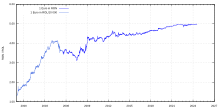Romanian leu
| Leu | |
|---|---|
| Country: |
|
| Subdivision: | 100 bani |
| ISO 4217 code : | RON |
| Abbreviation: | l |
|
Exchange rate : (August 24, 2020) |
1 EUR = 4.84 RON 1 CHF = 4.498 RON |
The leu ([ leu̯ ], plural: lei , German: "lion") is the currency of Romania . It is divided into 100 Bani (German: "Geldstück" or generally "Geld"). The name of the currency is traced back to the fact that Dutch lion talers circulated in the Romanian principalities in the 17th century . The exchange rate against the mark, determined under the gold standard, was 1.25 lei in 1912. The current means of payment with the ISO 4217 code RON, numerical code 946, was introduced on July 1, 2005 and replaced the old currency (code ROL) at a ratio of 1: 10,000. The currency symbol is L .
history
The leu was introduced on April 22, 1867 as a bimetallic currency, weighted with a leu equal to 5 grams of silver of 83.5% or 0.29032 grams of gold. After 1878, the Russian silver ruble ousted the domestic currency from payment transactions . Romania reacted to this development by introducing a gold currency in 1889 , which was converted into silver coins up to max. 50 lei was added.
On August 15, 1947 a currency reform was carried out. One new leu was the equivalent of 20,000 old lei. The external value of the reformed currency to the US dollar was one dollar = 150 lei. On January 28, 1952, another reform of the existing currency system was carried out. There were various exchange rates, between 20 and 400 old lei were exchanged for a new lei.
Between 1970 and 1989, the official exchange rate was regulated by law in order to stabilize the foreign trade value. Due to a lack of foreign currency, however, foreign currency was not available to private individuals.
After the end of the Ceaușescu era , inflation rose sharply as part of the economic transformation. On July 1, 2005, the central bank introduced the new Romanian leu and corrected its monetary policy to lower inflation rates. One new Romanian Leu is equivalent to 10,000 old Romanian Lei (ROL). The old and new coins and banknotes were also used as official tender until the end of 2006.
Circulation coins in Romania
First coins
In 1867 the first coins with the denominations of 1, 2, 5 and 10 Bani appeared; 20 gold coins followed in the following year. Between 1870 and 1873 silver coins of 50 bani as well as 1 and 2 lei followed and in 1880 5-lei silver coins. The largest face value was minted with 100,000 lei shortly before the currency reform in 1947. A selection can be found in the table below.
| Face value | image | material | Weight | diameter | thickness | Issue date |
|---|---|---|---|---|---|---|
| 10 Bani |

|
95% copper 4% tin 1% zinc |
10 g | 30 mm | 1867 | |
| 5 lei |

|
90% silver 10% copper |
25 g | 37 mm | 2.6 mm | 1883 |
| 1 ban |

|
95% copper 4% tin 1% zinc |
1 g | 15 mm | 1900 | |
| 10 Bani |
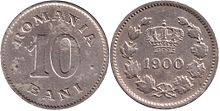
|
75% copper 25% nickel |
4.5 g | 22 mm | 1900 | |
| 1 leu |
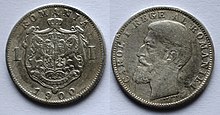
|
83.5% silver 16.5% copper |
5 g | 23.3 mm | 1.4 mm | 1900 |
| 1 leu |

|
83.5% silver 16.5% copper |
5 g | 23 mm | 1.4 mm | 1906 |
| 2 lei |

|
83.5% silver 16.5% copper |
10 g | 27 mm | 2 mm | 1912 |
| 1 leu |

|
83.5% silver 16.5% copper |
5 g | 23 mm | 1.4 mm | 1914 |
| 100 lei |

|
50% silver 40% copper 5% zinc 5% nickel |
14 g | 31 mm | 2.4 mm | 1932 |
| 1 leu |

|
80% copper 19% zinc 1% nickel |
2.75 g | 18 mm | 1.55 mm | 1938 |
| 500 lei |

|
70% silver 30% copper |
12 g | 32 mm | 1944 | |
| 10,000 lei |

|
63% copper 37% zinc |
7.5 g | 27 mm | 1947 | |
| 100,000 lei |

|
70% silver 30% copper |
25 g | 37 mm | 1946 |
Second series
On August 15, 1947, the second series of lei coins before the overthrow of King Michael I was issued in denominations of 50 Bani, 1, 2 and 5 Lei. After the founding of the People's Republic of Romania , new coins denominated 1, 2, 5 and 20 lei were issued between 1948 and 1952.
| Face value | image | material | Weight | diameter | thickness | Issue date |
|---|---|---|---|---|---|---|
| 50 bani |

|
80% copper 19% zinc 1% nickel |
1.7 g | 16 mm | 1947 | |
| 1 leu |

|
63% copper 37% zinc |
2.5 g | 18 mm | 1947 | |
| 2 lei |
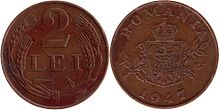
|
92% copper 8% zinc |
3.5 g | 21 mm | 1947 | |
| 5 lei |

|
aluminum | 1.5 g | 23 mm | 1947 |
Third series
From 1960, the third series of the leu currency was issued. Coins were minted in values of 5, 15 and 25 Bani, as well as 1 and 3 Lei in steel with a nickel coating. After 1975 all denominations, with the exception of the 3-lei coin, were gradually replaced by aluminum. From 1978, the series was completed with a 5-lei coin.
| Face value | image | material | Weight | diameter | thickness | Issue date |
|---|---|---|---|---|---|---|
| 5 Bani |

|
95% steel with 5% nickel plating |
1.7 g | 16 mm | 1.3 mm | 1966 |
| 15 Bani |
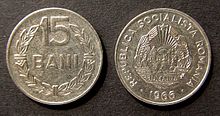
|
95% steel with 5% nickel coating |
2.87 g | 19.5 mm | 1.4 mm | 1966 |
| 25 Bani |

|
95% steel with 5% nickel coating |
3.38 g | 22 mm | 1.4 mm | 1966 |
| 1 leu |

|
95% steel with 5% nickel coating |
5.06 g | 24 mm | 1.6 mm | 1966 |
| 3 lei |

|
95% steel with 5% nickel coating |
5.86 g | 27 mm | 1.6 mm | 1966 |
| 5 lei |

|
aluminum | 2.8 g | 29 mm | 1.8 mm | 1978 |
After the regime change, new coins with values between one leu and 100 lei were issued, from 1999 onwards, as a result of the high inflation that began in 1990, coins with a value of 500 lei, one year later with a value of 1000 lei and in 2001 finally twelve-sided 5000 lei coins introduced. The latter had a value of 5, 10 and 50 bani after the currency conversion in a ratio of 1: 10,000.
Current coins
The fourth and final series followed in 2005. The current coins have denominations of 1, 5, 10 and 50 Bani. All coins of the last series were minted with the state title, coat of arms , year of minting and the numerical value.
| Face value | image | material | Weight | diameter | thickness | Issue date |
|---|---|---|---|---|---|---|
| 1 ban |
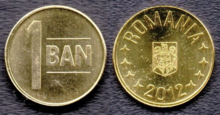
|
Steel with brass coating | 2.4 g | 16.75 mm | 1.6 mm | July 1, 2005 |
| 5 Bani |

|
Steel with a copper coating | 2.78 g | 18.25 mm | 1.6 mm | July 1, 2005 |
| 10 Bani |

|
Nickel-plated steel | 4.0 g | 20.5 mm | 1.8 mm | July 1, 2005 |
| 50 bani |

|
80% Cu , 15% Zn , 5% Ni | 6.1 g | 23.75 mm | 1.9 mm | July 1, 2005 |
Banknotes in Romania
First leu
Banknotes were introduced in 1877 with the denominations of 5, 10, 20, 50, 100 and 500 lei. In 1881 the Romanian National Bank began to issue notes with the face value of 20, 100 and 1000 lei on a regular basis. In 1917 the Ministry of Finance issued notes of 10, 25 and 50 bani. In 1940, 500 lei banknotes were introduced.
Second leu
In 1947 the Ministry of Finance introduced 20 lei notes and the Romanian National Bank introduced 100, 500 and 1000 lei notes. In 1949, the Bank of the Romanian People's Republic took over the production of paper money and issued 500 and 1000 lei notes.
Third leu
In 1952, the Ministry of Finance introduced 1, 3 and 5 lei notes and the Bank of the Romanian People's Republic introduced 10, 25 and 100 lei notes. In 1966, the National Bank of the Romanian Social Republic took over the production of all paper money and issued notes of 1, 3, 5, 10, 25, 50 and 100 lei. In 1991, 500 and 1000 lei notes were introduced, and in 1992 200 and 5000 lei notes. 10,000 lei followed in 1994, 50,000 lei in 1996, 100,000 lei in 1998, 500,000 lei in 2000 and 1 million lei in 2003. From 1999, the paper notes were replaced by polymer notes.
25 lei (1966 with Tudor Vladimirescu )
50 lei (1966 with Alexandru Ioan Cuza )
100 lei (1966 with Nicolae Bălcescu )
Current banknotes
In 2005, polymer notes for 1, 5, 10, 50, 100 and 500 lei were introduced. 200 lei banknotes were added in 2006. The designs of 1, 5, 10, 50, and 100 lei notes are based on the design of the earlier 10,000, 50,000, 100,000, 500,000, and 1 million lei notes that they replaced. The 10-lei notes were redesigned in November 2008.
Notes in circulation before the currency reform and their equivalent after the currency reform:
- 10,000 lei = 1 leu
- 50,000 lei = 5 lei
- 100,000 lei = 10 lei
- 500,000 lei = 50 lei
- 1,000,000 lei = 100 lei
Romania was the first European country to introduce polymer banknotes and the first country in the world with a second series of these banknotes.
| Face value | image | portrait | size |
|---|---|---|---|
| 1 leu |
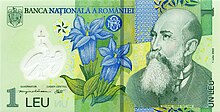
|
Nicolae Iorga | 120 × 62 mm |
| 5 lei |
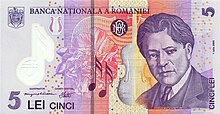
|
George Enescu | 127 × 67 mm |
| 10 lei |

|
Nicolae Grigorescu | 134 × 72 mm |
| 50 lei |

|
Aurel Vlaicu | 140 × 77 mm |
| 100 lei |

|
Ion Luca Caragiale | 147 × 82 mm |
| 200 lei |

|
Lucian Blaga | 150 × 82 mm |
| 500 lei |

|
Mihai Eminescu | 153 × 82 mm |
New bills
In 2016, the Romanian national coat of arms was changed slightly by adding a crown to the eagle. Accordingly, appropriately adjusted banknotes will be issued beginning on January 1, 2018.
Security features
In order to make counterfeiting more difficult and to increase the degree of identification, every banknote has several security features. Are used z. B. a small hole grid (Microperf) by means of micro-perforations in the substrate, see-through window and reflection marks.
Euro introduction
In the course of the country's admission to the European Union on January 1, 2007, the National Bank set itself the monetary policy goal of introducing the common currency, the euro, by 2014 at the latest. However, the project failed.
The new goal is to introduce the euro by 2024, which the Romanian financial expert Florin Cîțu only believes to be possible after 2028. In this case, 20 of the 27 Member States would have the euro as their currency.
Trivia
The 10-bani note from the emergency money series from 1917 is one of the smallest banknotes of all time.
Individual evidence
- ↑ see: List of exchange rates (gold standard)
- ↑ Otto, Carl; The house secretary; Berlin 1913, p. 485, 3rd cover page
- ↑ see: Romanian Chamber of Deputies, Law on the Romanian Coat of Arms (Romanian)
- ↑ Banknotes ( Memento from April 9, 2016 in the Internet Archive )
- ↑ Banca Naţională va lansa în circulaţie bancnote şi monede cu noua stemă a ţării , Adevărul December 21, 2017
- ↑ Monetary union is getting bigger: Euro family is growing: The next candidates after Lithuania - economic news. Retrieved July 3, 2015 .
- ↑ Allgemeine Deutsche Zeitung: Government wants to introduce the euro by 2024. ADZ , February 1, 2019, accessed on August 23, 2020 .
- ↑ Who has the smallest? PostFinance, March 2, 2017, accessed on October 24, 2019 .
